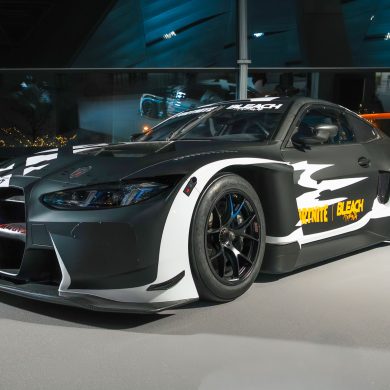Car names have always fascinated me. Brands yes, but particularly model names. There have been countless quirky ones over time, and many that have stood the test of time.
Did you know one of the names under consideration for what became the Edsel was “Utopian Turtletop?” Whatever that is. Shelby’s Cobra was and remains perfect for that iconic roadster. So many of the Italian car names have the rhythm and the romance that goes along with that language:
De Tomaso Pantera always sounded good on my ear. Ferrari had the SuperFast and the SuperAmerica. Mustang was an inspired choice for Ford’s world-changing pony car in 1965. Thunderbird was another particularly brilliant naming choice.

In the mid-50s Dodge began to backhandedly acknowledge how important women are in the automotive purchase and ownership process, so they developed a special model tailored (or so they thought) to “Her Majesty, the American Woman.”
This full-sized luxury two-door hardtop came only in the two-tone paint combination of Sapphire White and Heather Rose (aka pink) and the exterior model badging was gold plated. The cabin was heavily brocaded, riffing on the same color palette as the exterior.
Each car came with a special purse outfitted with all sorts of cosmetic aids, a wallet, coin purse, and a cigarette lighter. The car also contained its own raincoat, bonnet, and umbrella in a special rear seat storage compartment. Dodge condescendingly named it the La Femme.
As you might guess, the La Femme La Failed for a variety of reasons. The first and most likely is that the entire concept was patronizing beyond words. A handful of women may have appreciated it, but the rest stayed away in droves. And men simply wouldn’t drive them.

Less than 2500 La Femmes were made during the car’s mercifully short two-year production run (1955-56) before this ill-conceived model option and name were put to rest. Forever.
A couple of more recent naming choices equally confound me. For decades, Mercedes-Benz model names clearly conveyed the series and model and the engine displacement. You may recall back in the 60s that Mercedes-Benz minted the original super sedan, called the 300 SEL 6.3, which denoted its exceptional, powerful, hand-built 6.3-liter engine. When the engine’s displacement was raised to around 6.9-liters, the car was renamed and rebadged as the 6.9. Further, about a decade back, Mercedes-AMG developed a new naturally aspirated 6.3-liter high-performance V-8 engine and called it – guess what – the 6.3. Logical enough, no?
When Mercedes-AMG retired that engine, it was replaced by a new twin-turbocharged V-8 of around 5.4-liters, and it’s a magnificent motor, boiling out well over 500 horsepower and more in some models. But those models continue to be named using the 6.3-badge reference; SL63, E63, and such.
In no way does the math of the new engine equal 6.3-liters even if you apply some mythical multiplier factor for the turbocharging. So at the engine’s media launch program, I asked one of the Mercedes product engineers “what’s up with the naming?” He somewhat arrogantly dismissed me with “oh you don’t understand. Because, you see: “6.3” has become a brand of its own, that people recognize as an exclusive performance label, and is no longer relevant to the size of the engine.”
You are correct Mr. Cocky Engineer, I don’t understand. I at least know that in the case of my SL500, it at least carries a 5.0-liter engine, no confusion about that.

Also, now we have the pure electric Porsche Taycan, introduced in two models, the Turbo and the Turbo S. Hmmm. To me, a car called a Turbo has or ought to have a turbocharged engine.
The Taycan doesn’t have an engine; it has motors. And thus doesn’t, nor can it have turbochargers. So that means that Porsche makes cars that have turbochargers that aren’t called Turbos (most current 3.0-liter Carreras), models that have turbos and are named Turbos, and now a line of cars that don’t have engines or turbos (Taycan) that are named Turbos.

At least none of them chose Utopian Turtletop. What are your thoughts? Comment below.










We were pleased to restore a 1914
O-We-Go. The ladies at the DMV were after me to register the car before it was finished.
Reason ? Because they wanted to see if the NYS auto fill computer form would accept Owego as a brand name. It did, without the hyphens. But did it recognize the brand or the village ???
All best,
Jim Mead
Owego, NY
Henry Ford II didn’t like the name Edsel. “I don’t fancy my father’s name spinning on a million hubcaps,” he said. Well, he never had to worry. Even at 4 per car, there were far from a million when the brand was killed.
How abut the VW Phaeton which is a sedan and has no folding cloth top.
If you want obscure car names, try this one! I raced a car in American S.C.C.A. named “Fairethorpe Electron Minor”, it was Triumph powered, and was actually pretty quick. The car was actually a production class car designed, and built in England. This was in the 1960s. I do not know how many were produced, but it could not be many.
Few wonder why “Audi”. August Horch, early automaker (1890s), had a falling- out w his partner, left to form his own company, couldn’t use name which belonged to the prior firm,. As his name means “hark” or “listen” in German, he used the Latin word.
Ransom E. Olds had the same problem when the recently-formed GM bought him out; hence, the Reo.